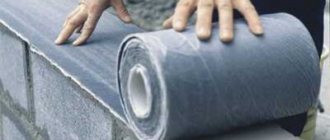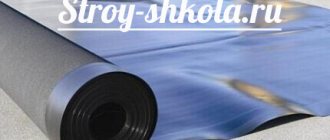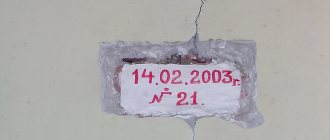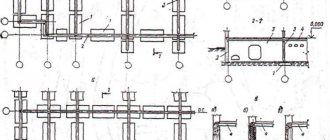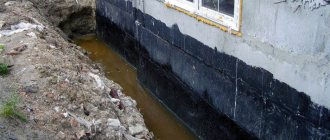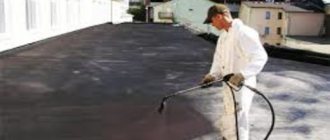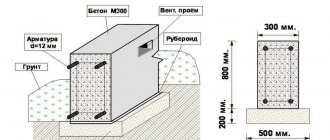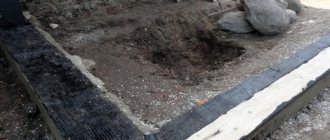Table of contents
Why is waterproofing needed When to carry out work on waterproofing a foundation Types of waterproofing foundations with a basement Coating waterproofing of a foundation Pasting waterproofing of a foundation The procedure for carrying out work on waterproofing a foundation Penetrating waterproofing of a foundation Conclusion Waterproofing a foundation is
one of those types of necessary construction work that should not be neglected in any case. Moreover, when it comes to installing a foundation with a basement, which is supposed to house premises for various household and technical purposes. The waterproofing device must strictly comply with the general norms and rules for carrying out this type of work.
Foundation with basement with waterproofing
Why is waterproofing needed?
The foundation part, located in the ground, is continuously exposed to groundwater and precipitation. Despite its apparent solidity, reinforced concrete (and this is the main and most common material for the construction of foundations with basements) is a rather porous material, that is, it allows moisture to pass through, albeit slowly. This is fraught with problems both for the foundation itself and for the basement. Steel reinforcement elements of the foundation without waterproofing begin to rust quickly and, as a result, lose their strength. There is probably no need to explain to anyone what this entails; the sad look of a strip foundation cracked along its entire height is familiar to many. A foundation without waterproofing is also susceptible to such a dangerous phenomenon as cycles of freezing and defrosting of water trapped in the pores under conditions of variable positive and negative temperatures, especially characteristic of the warm winters of the era of global warming. Freezing water breaks the surrounding concrete, in which microcracks form.
For a foundation with a basement without waterproofing, there are obvious problems associated with its operation.
- These include:
- High indoor humidity
- Formation of fungi and mold
- The appearance of a putrid odor
- Flooding of part of the basement
The level of complexity of foundation waterproofing work depends on the depth of groundwater at the construction site. If groundwater lies more than one meter below the base of the foundation, you can limit yourself to the simplest coating waterproofing. In the event that groundwater is located at a depth of less than one meter, waterproofing work is strictly necessary. And finally, if the groundwater level is higher than the base of the foundation, even thorough waterproofing may not be enough. Here it is necessary to create a drainage system to drain water from the foundation area.
Scheme of foundation waterproofing with drainage system
An additional point is the presence of pressure groundwater at the construction site - they impose additional requirements for waterproofing.
General rules for waterproofing
Scheme of waterproofing the foundation of a house
Regardless of the materials used and the technologies used, you should follow the list of general rules for waterproofing work:
- Waterproofing should be carried out at a stable positive temperature of at least +5°C, at least for a week.
- The surface of the basement/foundation walls must be clean.
Before starting work, it must be cleaned with a stiff brush. The easiest way to get rid of heavy dirt is to rinse the base with water under pressure.
- Any irregularities must be eliminated. Large depressions are usually filled with cement-sand mortar or special repair compounds. Small ones are covered with frost-resistant tile adhesive. Particular attention should be paid to prefabricated structures. Their seams should also be filled.
- Waterproofing of structures must be complete, i.e. it must be done from below, from the inside and from the outside.
Important! Carelessness in the work will certainly affect the quality and water (in some places) will flow into the basement, gradually moistening the entire foundation.
- Strictly following the instructions for using materials for waterproofing will only have a positive effect on the final result.
When to carry out foundation waterproofing work
These types of work are best done immediately after installing the foundation itself. This is due to the fact that the surface of the foundation wall immediately after installation is the smoothest, free of cracks and dirt, and there is easy access to it. Waterproofing work should be carried out in dry weather at an ambient temperature of at least five to ten degrees. If the condition of the surface is unsatisfactory, it is necessary to cover all cracks and potholes with a moisture- and frost-resistant cement composition intended for waterproofing. A foundation made of reinforced concrete foundation blocks requires a particularly careful approach, in which you need to pay attention to the interblock seams.
Important! As the famous saying goes, “water will find a hole.” This fully applies to foundation waterproofing work. They must be carried out with the utmost care over the entire surface. Otherwise, if there is at least one area that is not well-waterproofed, all the work will go down the drain. Because it is through this area that water will flow inside, gradually filling the entire foundation.
Types of waterproofing foundations with a basement
Waterproofing of foundations is divided into vertical and horizontal . When carrying out vertical waterproofing work, vertical external walls exposed to groundwater, flood water and precipitation are treated. Horizontal waterproofing protects the basement floor from capillary rise of groundwater. A specific type of horizontal waterproofing includes a blind area, which plays a large and important role in removing atmospheric moisture from the foundation.
Based on the method used to apply waterproofing material to the surface of the foundation, a distinction is made between coating (sometimes called painting), pasting , penetrating and sprayed waterproofing. A combination of them for one foundation is also possible.
Types of insulation used
To the question - is foundation waterproofing necessary? Any builder will answer unequivocally - yes!
To protect buildings from the effects of water, hydraulic insulation is used. Waterproofing methods are quite varied and therefore, when choosing a hydraulic insulation method, it is advisable to understand how they work.
When choosing a hydraulic insulation method, it is necessary to take into account the material from which the building structure is made. In addition, it is necessary to understand where the building’s water comes from. This could be groundwater, the effects of precipitation, etc. You must also understand that the water that gets into the foundation gradually gets to the walls and enters the house. That is why a layer of hydraulic insulation is laid on the surface of the foundation.
Coating waterproofing of the foundation
This type of waterproofing is produced using three types of products - hot bitumen, bitumen mastics, and also special water-based mastics. Bitumen mastics are a mixture of bitumen with various polymer compounds and plasticizers. Recently, bitumen-rubber and bitumen-polymer mastics have become widespread. They have a number of advantages over traditional bitumen - they are more durable and better resistant to mechanical deformation. Water-based mastics are a bitumen-latex emulsion. Water-based mastics are applied to a moistened surface.
Many formulations on the market are ready for immediate use and do not require heating.
Coating waterproofing for foundations
The process of applying coating waterproofing to walls is simple, but it requires precision and accuracy. First, you need to prepare the base. To do this, you must first prime the foundation walls on both sides. To do this, use a solution of bitumen mastic in a solvent, the so-called primer. The surface is treated in two layers - first a primer with a slowly evaporating solvent is used, and the second layer is already coated with a primer with a quickly evaporating solvent. Next, the mastic itself is applied to the treated surface. Processing is carried out in two layers. In this case, the second layer is applied only after the first layer has completely dried. The lower the temperature, the longer it will take to dry. To increase the protective properties, it is recommended to use reinforcing meshes, which are laid on the first layer of waterproofing that has not yet hardened and are recessed inside by rolling a roller. After the second layer has hardened, you can backfill the soil under the foundation. To perform this work you will need a hard brush, a plastic roller and a spatula.
Applying bitumen mastic to the foundation surface
The advantages of coating bitumen mastics include seamless coating and tightness, subject to application technology. The disadvantages include their fragility, especially in the presence of pressure groundwater. Over time, mastics of this type lose mechanical strength, which is reflected in the occurrence of cracks and peeling from the concrete surface.
Coating method in isolation
Regardless of the brand and composition of the insulation used for coating waterproofing of the foundation, the sequence of operations for its use comes down to the following scheme:
- The surface to be treated is cleaned of traces of old coatings, dust and dirt.
- A primer composition is applied to the surface; most often it is a more fluid version of the base material. This operation will increase the adhesion of the waterproofing layer and the wall.
- Once the layer of primer material has been applied, the main layer of hydraulic insulation can begin to be laid. Depending on the brand, it can be applied using all acceptable methods, for example, using spray guns or brushes.
A high-quality coating will be obtained after several layers of the base coating have been laid on the foundation walls. This especially applies to mastics made on the basis of mineral materials, in the form of water-repellent and expanding cement.
Pasted waterproofing of the foundation
The progenitor of this type of waterproofing is the well-known rolled material roofing . It is still actively used in construction and is the most affordable. But technical progress does not stand still; now roll materials have appeared on the market that far surpass it in their characteristics. Their names depend on the manufacturer - these are, for example, stekloizol, uniflex, filizol, hydroizol, bikrost, technoelast, icopal, etc. These are mainly bitumen-based materials with special additives based on various polymers, thermoplastics and vulcanized rubber.
Bitumen-polymer coatings for foundation waterproofing
Purpose of waterproofing
Do-it-yourself comprehensive waterproofing of the foundation will reduce the risks of premature destruction of the entire house.
- The basis of the entire structure is the foundation; a significant part of it is located in the soil layer, in close contact with the ground.
- Rain and groundwater constantly impact it from the outside, causing inevitable destruction.
- The penetration of groundwater into basements and basements causes their flooding and erosion of the internal parts of the foundation.
- Constant dampness and high humidity provoke the growth of mold fungi in the lower floors of buildings.
- Temperature changes are especially dangerous - during frosts, residual moisture in the foundation freezes and expands, increasing its microcracks and pores. Over time, their size increases, thereby reducing the foundation’s resistance to loads and the total weight of the entire structure.
All this can be avoided by including waterproofing of the foundation and blind area in the estimate at the design stage of the building.
The procedure for carrying out work on waterproofing the foundation
Before installing roll waterproofing, the foundation surface must be treated with primers - bitumen primers. A layer of bitumen mastic heated to a high temperature (at least 150 degrees) is applied to the prepared foundation surface, distributing it evenly throughout the entire working area. Then the roll material is applied. The strips are glued with an overlap of twenty centimeters, with each new strip covering the old one. Gluing proceeds from the bottom up, and it is necessary to smooth the canvas so that air bubbles do not form.
When using waterproofing using the fused method, special roll materials are used, with a bitumen or polymer composition applied to them. During installation, the deposited layer must be heated with a gas burner until it melts and glued to a previously primed base.
Installation of roll waterproofing using a welded method using a gas burner
When installing roll waterproofing, special attention is paid to the joints, which are additionally covered with mastic, on which strips of rolled material are laid, which in turn is protected on top with hot bitumen.
Roll materials are applied in several layers, each new layer in turn is coated with bitumen mastic.
The undoubted advantages of roll waterproofing include its durability and reliability. However, its installation is much more complicated than coating and requires higher qualifications and sometimes special equipment, for example, gas burners. It also places higher demands on the condition of the surface, which must be smooth with deviations of no more than two millimeters. The presence of a larger number of butt seams requires their special processing, which increases the installation time.
General waterproofing technology
1. Preparatory work for the implementation of roll insulation has several stages. The same steps are followed when performing adhesive waterproofing of the TechnoNIKOL foundation.
- Leveling the surface of the foundation, eliminating protrusions and grouting depressions and sinkholes with cement mortar - complete correction of concreting defects.
- Filling expansion joints with sealant.
- Surface preparation. The substrate must be dry, free of grease, debris, dirt, rust and paint to maintain good adhesion.
- Priming the surface and drying it.
- Treatment of the base with a coating waterproofing material and complete hardening of the latter.
Coating waterproofing of foundation with mastic
2. Self-adhesive waterproofing materials are attached to the prepared base, pressing them tightly and rolling them over them with a roller. If waterproofing is carried out on a horizontal surface, then the layout is selected in such a way that the least number of seams is formed. The length of the material sheets must correspond to the height of the foundation for vertical waterproofing. The permissible overlap of the strips is from 10 to 15 millimeters, the second layer is applied with the center of the strips at the junction of the previous ones, in compliance with the checkerboard order. The connections are coated with mastic or polymer-based glue.
3. Materials used to protect the base from water can also be attached using the floating method. Due to the layers of bitumen mastic applied to them, they must be treated with high temperature. A special gas burner is used for this. Two people should participate in the work process, especially when it comes to waterproofing vertical surfaces.
The roll must be placed with the working side to the base and, systematically warming it up, rolled it out and pressed against the surface of the foundation.
4. Those waterproofing materials that need to be glued independently should be laid in a similar way, but only after using an adhesive. As for how many layers should be applied, this will depend on the water pressure: for seeping water - from 2 layers, and from 3 layers - if the hydrostatic pressure is from 0.1 MPa.
5. Vertical waterproofing requires additional protection of building brick, concrete or insulated structures. Otherwise, the adhesive waterproofing of the foundation may be damaged due to settlement of the building’s base and periodic soil movements.
6. When carrying out waterproofing on both vertical and horizontal surfaces, the overlap angles should be at least 30 centimeters.
7. When installing a drainage pipe system, the insulation must be installed below the drainage level so that water flows out through the pipes. If groundwater is at a high level, then drainage is performed along the total length of the foundation below its depth.
8. Backfilling is carried out with coarse-grained quartz, which easily allows liquid to pass through and it is collected in a certain place in the drainage system, which helps reduce the pressure on the insulating coating.
9. To protect the foundation from precipitation, a blind area is created, which also performs waterproofing functions.
The blind area also serves as insulation for the foundation. You can find out how to make a concrete or any other blind area in our article. When making it, you will need a concrete solution, which is also easy to mix yourself - you will find the entire process from calculation to visual video at the link:.
Let's take a closer look at waterproofing technology using membrane roll material.
Return to content
Penetrating foundation waterproofing
For reinforced concrete strip foundations, another type of surface treatment is penetrating waterproofing. This material is a sand-cement mixture with various chemical reagents. When it is used, a chemical reaction occurs between the concrete components and the chemicals that make up the penetrating waterproofing. As a result, special substances penetrate into the thickness of the concrete foundation, which fill micropores, cracks and air cells. This occurs due to the formation as a result of this chemical reaction of insoluble salts that are resistant to moisture. The penetration depth can be up to forty centimeters.
Penetrating waterproofing Penetron
The method of applying penetrating waterproofing is not complicated, which can be called its undoubted advantage. It is applied to the concrete surface with a roller or brush. In this case, the surface must be moistened. The advantages of this material include the ability to be applied to concrete that has not yet completely hardened, which speeds up the overall construction time. The mixture is prepared according to the instructions for use of the product. It is diluted with water until the consistency of sour cream is obtained. Next, the mixture is applied with a brush, brush or roller in two layers. Moreover, the second layer is applied a few hours after the first. Penetrating waterproofing is used for both exterior and interior basement foundation walls. It has also proven itself well as an additional type of treatment in combination with roll waterproofing. However, it should be remembered that the scope of its application is reinforced concrete foundations and for such highly porous materials as foam concrete it is completely unacceptable. When pouring the foundation layer by layer, it is also undesirable because of the air voids that form as a result.
Application of penetrating waterproofing
Features of waterproofing depending on the type of foundation
There is no fundamental difference between how to waterproof a foundation outside and inside a building, however, there are still certain features in these moments.
, bitumen-based mastics or a special rubber mass sprayed onto the concrete surface mainly used Rolled materials are used mainly to protect the surface of the foundation, which is planned to be below the level of backfilling with soil.
In part, internal work can be carried out during the construction of the building in the future, when the walls and roof will be erected and finishing work will be carried out.
Slab
For this type, both roll materials and coating materials are used. Rolled materials , for example, PVC film or roofing felt, insulate the lower surface from the penetration of moisture from the soil into the slab, and coating materials are used on top to eliminate capillary penetration of moisture into the building.
Pile
For pile foundations, most often used for buildings with light loads, for example, prefabricated panel or wooden buildings, waterproofing is selected depending on the type of piles used:
- for metal screw piles, additional treatment is carried out with a protective primer;
- for metal piles , which are subsequently filled with concrete and externally treated with protective paint and mastic;
- for concrete piles , painting with mastic is usually carried out.
Subsequently, the first beam is impregnated in several stages with a water-repellent composition and a protective agent to protect against biological pests of wood.
Columnar
In places where it is planned to install formwork under the pillars, initially a fence is made from roofing material inside of which a metal reinforcement frame of the column is installed. Pouring a concrete column in this case is reminiscent of filling a cup with ice cream, where the role of the cup is played by a roofing felt form.
Tape in the ground
In buildings where a strip type of base is provided, to install a protective layer, first of all, it is necessary to provide access to the base surface.
For buildings with a heavy load and the use of concrete foundation blocks, the trench is usually made slightly wider and the foundation, after installation, is first finished with a cement-sand composition with the addition of special water-repellent additives, and only then roll or mastic products are used.
For small strip foundations, it is rational to simply install a layer of waterproofing made of polyethylene film.
Pile grillage
Foundation waterproofing unit
For this type of base, combined waterproofing methods - roofing felt or polyethylene sleeves in the columns, and rolled materials are placed in the grillage.
After removing the formwork and drying the concrete, the edges of the rolled waterproofing are additionally glued to the concrete using mastic.

